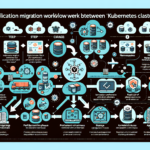Migrating workloads between datacenters is a complex process that requires careful planning, execution, and validation to ensure minimal disruption to services. Below is a step-by-step approach for a successful migration:
1. Planning and Assessment
a. Inventory Assessment
- Identify all the workloads, applications, servers, storage, and dependencies involved.
- Categorize workloads based on criticality, priority, and complexity.
b. Dependency Mapping
- Use tools like Application Dependency Mapping (ADM) or network monitoring tools to understand the interconnections between applications, servers, and databases.
c. Network and Bandwidth Planning
- Ensure the target datacenter has sufficient network bandwidth to handle the migration.
- Plan for connectivity between the source and target datacenters, such as VPN, dedicated lines, or cloud interconnects.
d. Migration Strategy
- Choose a migration approach based on the workloads:
- Lift-and-Shift: Move workloads as-is without modification.
- Replatforming: Make minor changes to optimize workloads for the new environment.
- Rearchitecting: Modify workloads significantly to take advantage of new technologies.
e. Downtime Requirements
- Determine whether the migration can be done with downtime (offline migration) or must be done live (live migration).
- Communicate downtime expectations with stakeholders.
2. Prepare the Target Datacenter
a. Infrastructure Readiness
- Ensure the target datacenter has adequate compute, storage, and network resources.
- Validate hardware compatibility (e.g., GPU cards for AI workloads or virtualization compatibility).
b. Network Configuration
- Configure VLANs, firewalls, IP address ranges, and DNS settings to match the requirements of the workloads being migrated.
c. Security Policies
- Align security protocols, access controls, and compliance requirements at the target datacenter.
- Consider data encryption during migration.
d. Testing Environment
- Set up a staging environment to test the migrated workloads before moving them to production.
3. Migration Execution
a. Backup and Snapshot
- Create full backups or snapshots of all workloads before starting the migration. Use tools like Veeam, Commvault, or native hypervisor backup solutions.
b. Workload Transfer
- Virtual Machines (VMs):
- Use tools like VMware vMotion, Microsoft Hyper-V Live Migration, or third-party solutions like Carbonite or Zerto.
- Containers/Kubernetes Workloads:
- Use tools like Velero for Kubernetes backup and restore or Helm charts to redeploy workloads.
- Ensure persistent volumes (PV) are migrated and attached properly.
- Physical Servers:
- Use tools like PlateSpin or manual OS and application reinstallation.
- Cloud Workloads:
- Use cloud migration tools such as AWS Migration Hub, Azure Migrate, or Google Cloud Migrate if applicable.
c. Data Migration
- Use storage replication tools such as SAN replication, NAS migration, or rsync for Linux-based workloads.
- For large datasets, consider asynchronous replication or shipping physical media (e.g., AWS Snowball).
d. Live Migration (If Needed)
- For critical workloads, use live migration tools to minimize downtime. Examples include VMware vMotion or similar technologies.
4. Testing and Validation
a. Post-Migration Validation
- Test workloads at the target datacenter:
- Verify performance metrics (CPU, memory, IOPS, latency).
- Ensure applications are functioning correctly.
- Test dependencies such as database connections, APIs, and integrations.
b. Network Testing
- Validate network configurations, connectivity, and DNS resolution.
- Test latency between applications and end-users.
c. Security Testing
- Run vulnerability scans and penetration tests to ensure the security posture is intact.
5. Cutover
a. Finalize Migration
- Once testing is successful, cut over workloads to the target datacenter.
- Redirect DNS and update IP addresses as needed.
b. Monitor Workloads
- Monitor workloads closely for a few days to identify and resolve any issues.
6. Decommission Source Datacenter
a. Cleanup
- Decommission workloads and infrastructure at the source datacenter once the migration is validated and stable.
- Ensure all sensitive data is securely wiped.
b. Documentation
- Update documentation with the new environment details.
Tools and Technologies
Below are some tools that can help streamline the migration process:
– Backup & Recovery: Veeam, Commvault, NetBackup
– Virtualization: VMware vSphere, Microsoft Hyper-V, Citrix XenServer
– Kubernetes: Velero, Helm, Kubernetes Cluster API
– Data Transfer: rsync, Robocopy, AWS Snowball
– Monitoring: SolarWinds, Nagios, Prometheus/Grafana
Best Practices
- Test Before Migration: Always test workloads in the target environment before moving to production.
- Automate Where Possible: Use automation tools to reduce manual errors and speed up migration.
- Communicate with Stakeholders: Keep all relevant parties informed about the migration timeline and impact.
- Plan for Rollback: Have a rollback plan in case something goes wrong during the migration.
Let me know if you need more details on specific aspects of the migration process!


